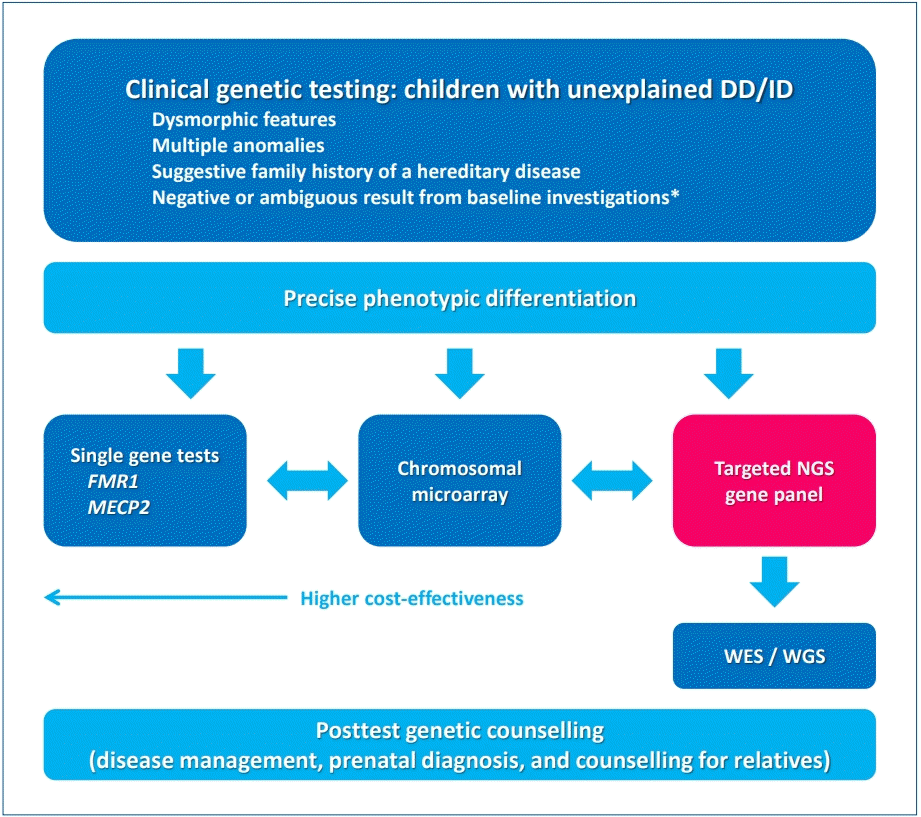Next-generation sequencing is a powerful method to enhance diagnostic yield in global developmental delay/intellectual disability
Article information
Next-generation sequencing (NGS) technologies are massively parallel DNA sequencing methods that allow faster and cheaper sequencing of nucleotides than does Sanger sequencing [1]. With the advent of NGS, nucleotide sequencing has found applications in the diagnosis of pediatric neurological disorders such as muscle disease, epilepsy, neurodegenerative disease, neurometabolic disease, and autism spectrum disorder [2-4]. In recent years, several studies on the genetic diagnosis of unexplained global developmental delay (DD) and intellectual disability (ID) have been published [5-7]. Global DD and ID have a high prevalence, affecting 1%–3% of children [8]. The diversity of phenotypical and genetical heterogeneity leads to a low diagnostic yield and insufficient clinical management [7].
When the clinical picture suggests a syndromic form of DD/ID, a diagnostic genetic test is used to confirm or rule out chromosomal abnormalities or monogenic disorders: classical karyotyping or fluorescence in situ hybridization or molecular biology testing (FMR1 for fragile X syndrome, MECP2 for Rett syndrome) [2]. As high-resolution chromosomal microarray (CMA) became widely used and provided a much higher diagnostic yield than traditional karyotyping, it became the first-tier of genomic analysis for patients presenting with DD/ID in the 2010 American College of Medical Genetics guideline [9]. NGS technologies have recently become a key diagnostic tool for establishing a genetic diagnosis in children with DD/ID, reducing the mean cost per diagnosis in cases that are generally more challenging to detect, such as mosaicism [7].
Han et al. [6] previously reported a diagnostic yield of 29% (10 of 25) in Korean patients with DD and/or ID. They suggested that targeted NGS through singleton analysis with a phenotypefirst approach is useful for genetic diagnosis. In this review article, Han emphasized a broad acceptance of NGS applications such as targeted panel sequencing (TPS), whole-exome sequencing (WES), and whole-genome sequencing (WGS) with reduced cost. Suggested guidelines for genetic investigations in children with DD/ID recommend TPS as the first-tier test and familybased trio testing by WES/WGS as the second-tier test, although a few technical limitations such as detecting microdeletions or duplications and mutations in noncoding trinucleotide expansion diseases [10]. Accordingly, an updated clinical approach to genetic investigations in children with DD/ID is shown in Fig. 1 [9,11]. The first step in increasing the diagnostic yield is to clearly define the population of suspected genetic causes that have dysmorphic features, multiple anomalies, suggestive family history of a hereditary disease, and negative or ambiguous results from baseline investigations. Another important consideration is that more detailed and precise phenotypic differentiations lead to a higher diagnostic yield of genetic diagnosis. After differentiating phenotypes, clinicians can choose the first-tier test with consideration of cost-effectiveness: single gene tests, CMA, or TPS. WES/WGS can help to identify a causative genomic variant in cases in which previous testing was inconclusive. Once a genetic diagnosis is established, posttest genetic counseling should address possible therapeutic interventions and the risk of recurrence.

Current clinical approach to genetic testing in children with developmental delay/intellectual disability. DD, developmental delay; ID, intellectual disability; NGS, next-generation sequencing; WES, wholeexome sequencing; WGS, whole-genome sequencing. *Baseline investigations: biochemistry (blood, urine±cerebrospinal fluid, muscle) and brain magnetic resonance imaging.
There are still many considerations related to advanced genetic testing that continuously reclassifying variants of unknown significance and ethical issues [11]. Nonetheless, the role of NGS testing in the clinical setting is becoming more important and clinicians should be aware of its rapid changes in this genetic era.
